Welcome to the colorful and playful world of parakeets! In this article, I will guide you through all you need to know about caring for these delightful birds. Parakeets, also known as budgerigars, are small and sociable birds that make wonderful companions. From creating a safe environment to understanding their unique personality traits, I will provide you with valuable insights and practical tips to ensure the well-being and happiness of your feathered friends.
As any parakeet owner knows, caring for these little birds goes beyond providing food and water. It’s about creating a nurturing and stimulating environment that meets their physical and emotional needs. Let’s dive into the key aspects of parakeet care and discover how you can provide the best possible care for your feathered friend.
Key Takeaways:
- Creating a safe environment with the right-sized cage and suitable placement is crucial for parakeet care.
- Provide natural branch perches, toys, and activities to keep parakeets mentally stimulated and engaged.
- A balanced diet consisting of quality pellets, fresh fruits, and vegetables is essential for their overall health.
- Regular grooming, including bathing, feather maintenance, and cage cleaning, helps keep parakeets in optimal condition.
- Bonding and training parakeets require patience, trust, and a gradual approach to establish a strong relationship.
Remember, parakeets are intelligent and social creatures, and with the right care and attention, they can bring endless joy and companionship to your life. So, let’s embark on this adventure together and ensure that your feathered friend thrives in their colorful and playful world.
Stay tuned for the upcoming sections where we will explore topics such as creating a safe environment, building the perfect parakeet cage, providing a balanced diet, and so much more. Let’s dive in and discover the wonderful world of parakeet care together!
Key Takeaways:
- Creating a safe environment with the right-sized cage and suitable placement is crucial for parakeet care.
- Provide natural branch perches, toys, and activities to keep parakeets mentally stimulated and engaged.
- A balanced diet consisting of quality pellets, fresh fruits, and vegetables is essential for their overall health.
- Regular grooming, including bathing, feather maintenance, and cage cleaning, helps keep parakeets in optimal condition.
- Bonding and training parakeets require patience, trust, and a gradual approach to establish a strong relationship.
The Basics of Parakeet Care
Before bringing home your new feathered friend, it’s crucial to understand the basic care requirements for parakeets. These delightful birds require a safe and comfortable environment, a balanced diet, regular grooming, mental stimulation, and proper health management. Let’s dive into the essentials of caring for these vibrant and intelligent creatures.
Cage Size and Placement
A suitable cage is essential for the well-being of your parakeet. It should be spacious enough to allow them to fly and move comfortably. As a general guideline, the cage should be at least 20 inches wide, 18 inches high, and 18 inches deep. Ensure that the bar spacing is narrow enough to prevent escape or injury.
Place the cage away from drafts, direct sunlight, and fumes, as these can be harmful to your pet. Additionally, proper ventilation is crucial to maintain a healthy environment for your parakeet.
Perches, Toys, and Activities
Parakeets are active and curious birds, so it is important to provide them with various perches and toys to keep them mentally stimulated. Natural branch perches, of different sizes and textures, help exercise their feet and prevent foot problems. Additionally, toys such as bells, swings, and puzzles provide entertainment and enrichment.
Offering a variety of activities, including training exercises and interactive playtime, helps maintain their physical and mental well-being. Spend time interacting with your parakeet outside of the cage, allowing them to explore their surroundings in a safe environment.
A Balanced Diet
A well-rounded diet is crucial for the optimal health of your parakeet. The majority of their diet should consist of high-quality pellets specially formulated for parakeets. Supplement their diet with fresh fruits and vegetables, such as apples, carrots, and leafy greens. Avoid feeding them avocados, chocolate, caffeine, and any other toxic foods that could harm their health.
Always provide fresh, clean water for your parakeet to ensure they stay hydrated. Clean food and water dishes daily to maintain hygiene and prevent the growth of harmful bacteria.
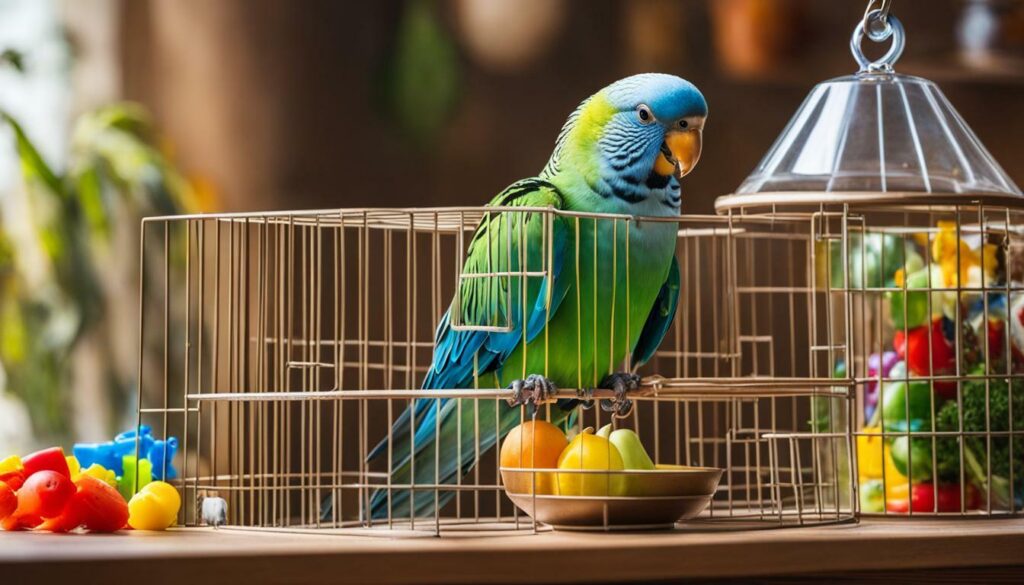
Regular grooming is essential to keep your parakeet looking their best. They need regular baths to maintain healthy feathers and skin. Provide a shallow dish of water for them to splash around in, or use a spray bottle to lightly mist them. Avoid using soap or shampoo, as it can strip their feathers of natural oils.
Feather maintenance is also important. Check for signs of feather abnormalities, such as plucking or damaged feathers, and consult a veterinarian if needed. Additionally, clean the cage and perches regularly to prevent the buildup of droppings and bacteria.
Caring for parakeets requires time, commitment, and a genuine love for these charming creatures. By providing them with a safe environment, a balanced diet, mental stimulation, and regular grooming, you can ensure that your parakeet lives a happy and healthy life as your beloved companion.
Creating a Safe Environment
A safe environment is paramount to the well-being of your parakeets, so let’s explore the essential factors to consider when setting up their habitat. Providing a secure and comfortable living space is crucial for their physical and mental health.
Firstly, choose a suitable cage that allows your parakeets to stretch their wings and move around freely. The cage should have proper bar spacing to prevent them from getting stuck or escaping. Additionally, ensure the cage is made of safe materials that are non-toxic to birds.
Place the cage in a quiet area away from drafts, direct sunlight, and any potential sources of fumes or chemicals. Parakeets are sensitive creatures and can easily be affected by these environmental factors. Proper ventilation is also important to maintain good air quality within the cage.

| Important Factors for a Safe Environment: |
|---|
| Choose a spacious cage with appropriate bar spacing |
| Place the cage away from drafts, direct sunlight, and fumes |
| Ensure proper ventilation |
Remember, parakeets thrive in a safe and calm environment, so it’s crucial to make their habitat as stress-free as possible.
In conclusion, creating a safe environment for your parakeets involves careful consideration of their cage, placement, and ventilation. By providing them with a secure living space, you can ensure their well-being and happiness as they explore and enjoy their surroundings.
Building the Perfect Parakeet Cage
A well-designed cage is essential for the happiness and health of your parakeets. Let’s explore what makes the perfect home for these playful birds.
When it comes to selecting a cage for your parakeets, size matters. The cage should be spacious enough to allow them to move freely, stretch their wings, and explore their surroundings. A minimum cage size of 18 by 18 inches is recommended for a single parakeet, but larger is always better. Remember, these birds love to fly and having plenty of room to do so will keep them content.

It’s also important to consider the bar spacing on the cage. Parakeets are small and agile birds, so the spacing between the bars should be narrow enough to prevent them from escaping or getting their heads stuck. A bar spacing of 1/2 inch to 5/8 inch is ideal.
| Perches | Toys | Activities |
|---|---|---|
| Provide natural branch perches of different widths to promote foot exercise and prevent foot problems. | Offer a variety of toys to keep your parakeets mentally stimulated, such as bells, swings, and puzzles. | Include activities like ladder climbs and foraging toys to keep them physically active and engaged. |
Parakeets are social birds that thrive on interaction and mental stimulation. In addition to perches, make sure to include a variety of toys and activities in their cage. This will keep them entertained and prevent boredom, which can lead to behavioral problems. A happy parakeet is an active parakeet!
The Importance of Mental Stimulation
Mental stimulation is crucial for the overall well-being of your parakeets. These intelligent birds require mental engagement to prevent boredom and promote a healthy mindset. By providing toys, perches, and training exercises, you can keep your parakeets mentally stimulated and physically active.
“A happy parakeet is an active parakeet!”
- Ensure your parakeet has a variety of toys, such as puzzle toys and interactive toys, to keep their minds sharp.
- Rotate their toys regularly to prevent monotony and introduce new challenges.
- Set aside time each day for training sessions to teach them new tricks and behaviors.
- Engage them with foraging toys that encourage natural instincts and provide mental stimulation.
By incorporating these mental stimulation techniques into your parakeet’s daily routine, you can help prevent boredom, promote their overall well-being, and strengthen the bond between you and your feathered friend.
| Tip | Health Check-Ups |
|---|---|
| Schedule regular veterinary check-ups to ensure your parakeet’s health and catch any potential issues early. | Monitor their behavior, appetite, and droppings for any signs of illness. |
Remember, a happy and healthy parakeet is a result of both physical and mental well-being. By providing them with a suitable cage, perches, toys, and activities, you are creating an environment that promotes their happiness and overall quality of life.
A Balanced Diet for Parakeets
Like us humans, parakeets benefit greatly from a nutritious and varied diet. Let’s discover the key elements to keep their tummies happy and healthy.
Parakeets thrive on a diet that includes high-quality pellets as the main staple. These pellets provide essential nutrients and vitamins needed for their overall health. Look for pellets specifically formulated for parakeets, as they are designed to meet their dietary requirements. It’s important to note that parakeets may be picky eaters, so you may need to try different brands to find the one your feathered friend prefers.
| Foods to Include | Foods to Avoid |
|---|---|
|
|
Remember, a balanced diet is essential for parakeets to maintain good health and prevent nutritional deficiencies. Offering a variety of foods will ensure they receive a broad range of nutrients.
Along with pellets and fresh produce, it’s important to include a source of protein in your parakeet’s diet. This can be achieved through the addition of small amounts of cooked chicken or hard-boiled eggs. Offering these as occasional treats will provide a boost of protein, which is beneficial for parakeets’ muscle development and overall well-being.
Importance of Water
Water is vital for a parakeet’s hydration and digestion. Make sure fresh, clean water is available at all times. Change the water daily to keep it free from contaminants. Providing a shallow dish or a specialized bird water dispenser will encourage your parakeet to drink regularly.
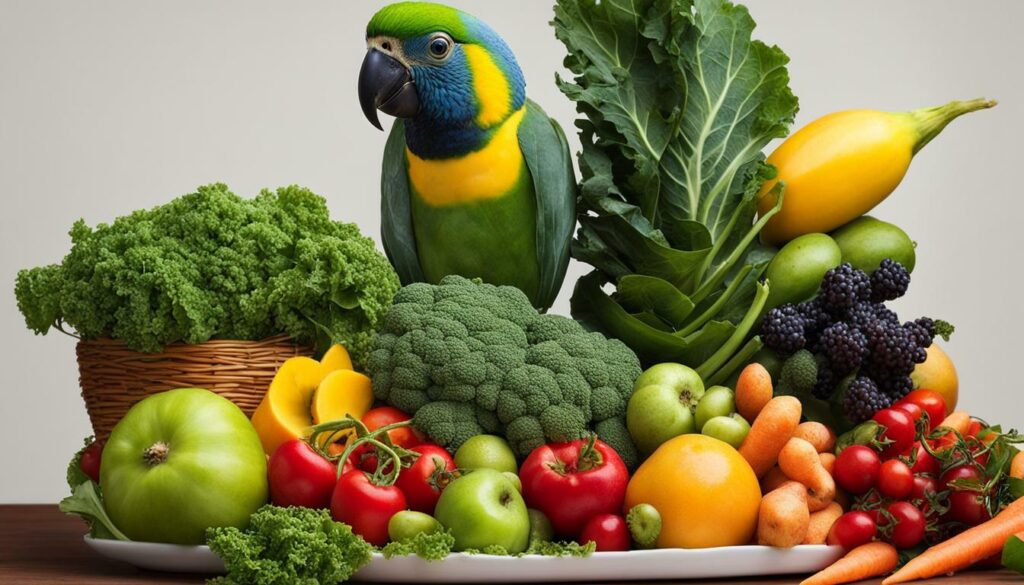
A well-rounded diet is the foundation for your parakeet’s health and happiness. Offering a variety of foods, including pellets, fresh fruits, vegetables, and occasional protein treats, will help keep your feathered friend in optimal condition. Remember to provide fresh water daily and monitor their food intake and preferences. By providing a nutritious diet, you are ensuring the well-being of your beloved parakeets.
Grooming and Maintenance
Just like any well-groomed pet, parakeets need a little upkeep to stay in tip-top shape. Let’s explore the grooming and maintenance routines that keep them looking and feeling their best.
Grooming for parakeets involves several essential tasks. First and foremost is bathing, which helps keep their feathers clean and healthy. You can provide a shallow dish of lukewarm water for them to splash around in or use a spray bottle to mist their feathers gently. This not only cleans their plumage but also helps them regulate their body temperature.

Feather maintenance is another important aspect of parakeet grooming. Regular preening helps them remove dirt, debris, and old feathers. You may notice your parakeet using their beak to smooth their feathers and keep them in place. Occasionally, they may require a little help by gently removing any broken or stuck feathers. Additionally, providing them with a cuttlebone or mineral block helps keep their beaks trimmed and healthy.
Cage cleaning is also crucial for maintaining your parakeet’s overall well-being. Regularly remove any droppings or soiled bedding from their cage, and wipe down the perches and walls with a bird-safe disinfectant. This helps prevent the buildup of bacteria and keeps your parakeet’s living environment clean and hygienic.
| Grooming Tasks | Frequency |
|---|---|
| Bathing | 2-3 times per week |
| Feather maintenance | Daily |
| Cage cleaning | Weekly |
By incorporating these grooming practices into your routine, you can ensure that your parakeet stays healthy, happy, and looking their best.
Mental Stimulation and Activities
Parakeets are intelligent birds that thrive when given opportunities for mental stimulation and engaging activities. Let’s dive into the exciting world of parakeet entertainment.
Providing a variety of toys is crucial for keeping your parakeet mentally stimulated. They love toys that encourage foraging behavior, such as puzzle toys that hide treats or toys with bells and mirrors that can provide both visual and auditory stimulation. It’s important to rotate your parakeet’s toys regularly to keep their environment fresh and interesting.
Another great way to keep your parakeet entertained is by providing perches of different sizes and textures. Natural branch perches not only provide a comfortable place for your parakeets to rest, but they also help keep their feet and nails healthy. You can also add rope perches or ladders to encourage climbing and exercise.
“Toys and mental stimulation are essential for the well-being and happiness of parakeets.”
Training exercises can also play a big role in keeping your parakeet mentally stimulated. They are highly trainable and can learn simple tricks, such as stepping onto your finger or retrieving objects. Training sessions not only provide mental stimulation but also help to strengthen the bond between you and your feathered friend.
Remember to always supervise your parakeet during playtime and remove any toys or objects that may pose a safety hazard. Safety should be a top priority when selecting toys and activities for your parakeet.
Parakeet Toys and Mental Stimulation: A Summary
- Provide a variety of toys that encourage foraging behavior and offer visual and auditory stimulation.
- Rotate your parakeet’s toys regularly to keep their environment fresh and interesting.
- Offer perches of different sizes and textures to provide a comfortable resting place and promote foot and nail health.
- Include training exercises to provide mental stimulation and strengthen the bond between you and your parakeet.
- Always prioritize safety and remove any hazardous toys or objects from your parakeet’s play area.
| Toy Type | Description |
|---|---|
| Puzzle toys | Toys that hide treats or require problem-solving to access rewards. Stimulates foraging behavior. |
| Bell toys | Toys with bells that provide auditory stimulation and promote playfulness. |
| Mirror toys | Toys with mirrors that allow parakeets to see their reflection, providing visual stimulation and companionship. |
| Rope perches | Perches made of rope material that provide varied textures and encourage climbing and exercise. |
Parakeets are intelligent and curious creatures, so it’s important to keep their minds active and engaged. By providing a range of toys, perches, and training exercises, you can ensure that your parakeet stays mentally stimulated and leads a happy, fulfilling life.

A healthy parakeet is a happy parakeet. Let’s explore the signs to watch out for and how to keep your bird in optimal health. Regular veterinary check-ups are essential to catch any potential health concerns early on. Certain symptoms may indicate a health issue, such as changes in appetite, weight loss, abnormal discharge, or excessive sneezing. If you notice any of these signs, it’s important to seek professional advice.
In addition to regular check-ups, managing stress is crucial for maintaining your parakeet’s well-being. Just like humans, birds can experience stress, which can weaken their immune system and make them more susceptible to illness. Ensure your parakeet has a peaceful and calm environment, away from loud noises, sudden temperature changes, or other sources of stress.
Common Health Concerns in Parakeets
Parakeets can be prone to certain health conditions. One common issue is respiratory infections, which can be caused by drafts, poor ventilation, or exposure to harmful fumes. Keeping your parakeet’s living space clean and providing proper ventilation is crucial to prevent these infections. Additionally, be aware of potential parasites such as mites or lice that can affect your bird. Regularly inspect your parakeet for any signs of infestation, such as itchiness or feather loss, and consult with a veterinarian for appropriate treatment.
Another important aspect of parakeet health is their diet. Nutritional deficiencies can lead to various health problems, including weakened immune systems and calcium deficiencies. Ensure your parakeet is receiving a balanced diet that includes high-quality pellets, fresh fruits, and vegetables. Avoid feeding them foods that are toxic to birds, such as chocolate or avocado. Consult a veterinarian for specific dietary recommendations based on your parakeet’s individual needs.
| Signs of a Healthy Parakeet | Signs of Illness or Distress |
|---|---|
| Alert and active | Loss of appetite |
| Bright and shiny feathers | Weight loss |
| Clear and bright eyes | Abnormal discharges (nasal, ocular, or fecal) |
| Smooth beak and nails | Excessive sneezing or coughing |
| Active chirping and mimicking | Changes in behavior or personality |
A healthy parakeet is an active and playful companion, always ready to chirp and engage in social interactions. Paying attention to their physical and behavioral changes can help you identify and address health concerns promptly, ensuring their overall well-being and happiness.
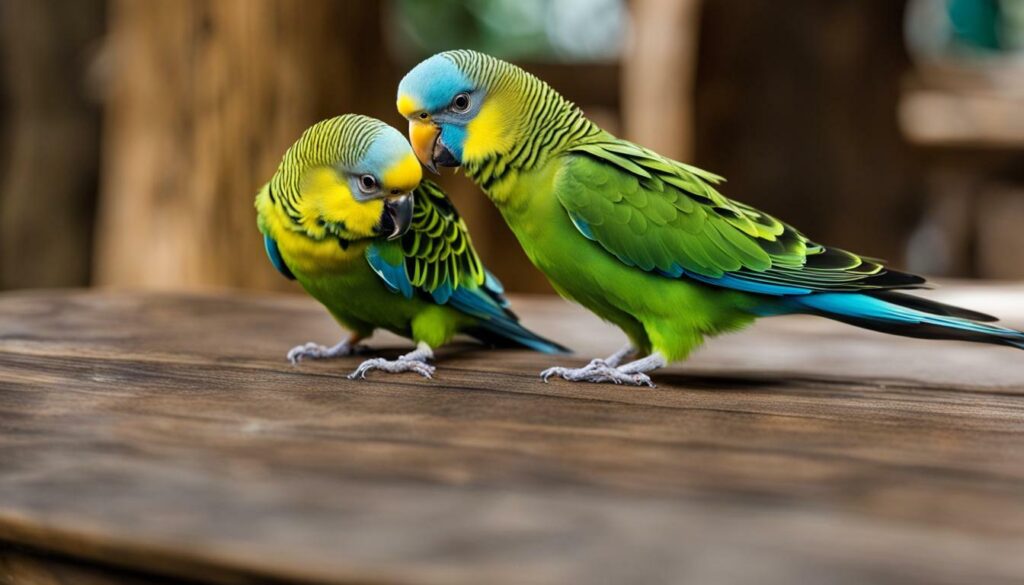
Building a strong bond with your parakeet is a rewarding and fulfilling experience. Let’s discover how to form a lifelong connection with your feathered companion.
Parakeets are highly social birds, and they thrive on companionship and interaction. To build trust and develop a bond with your parakeet, it’s essential to spend quality time with them every day. Start by talking softly to your bird and offering them treats from your hand. This will help them associate your presence with positive experiences.
Once your parakeet becomes comfortable with your presence, you can gradually introduce more interactive activities. Consider using toys and puzzles designed for parakeets to engage them mentally and provide entertainment. Rotate their toys regularly to keep them engaged and prevent boredom. Additionally, creating a stimulating environment with perches and branches can encourage exploration and exercise.
| Training Tips for Parakeets |
|---|
| Use positive reinforcement: Reward your parakeet with treats and praise when they exhibit desired behaviors, such as stepping onto your finger or repeating certain sounds. |
| Start with simple commands: Teach your parakeet basic commands like “step up” or “step down” using treats as motivation. Be patient, and repeat the commands consistently. |
| Clicker training: Utilize a clicker to mark desired behaviors and reinforce positive actions. Pair the clicker sound with treats to create a positive association. |
| Gradual introduction to handling: Introduce your parakeet to handling slowly and gently. Start by letting them perch on your finger and gradually increase the duration of handling sessions over time. |
Remember, every parakeet is unique, and it may take time for your bird to feel comfortable and respond to training methods. Patience, consistency, and positive reinforcement are key to building trust and achieving successful training outcomes.
Forming a Lifelong Connection
Parakeets are intelligent birds that can develop strong bonds with their human companions. By dedicating time and effort to their care and training, you can forge a lifelong connection with your parakeet. Remember to approach training sessions with a positive and calm demeanor, as birds are highly perceptive to human emotions.
Keep in mind that every parakeet has its personality and may have different preferences and learning abilities. Tailor your training approach to suit the needs of your specific bird, and always be mindful of their well-being and comfort.
With patience, love, and dedication, you can establish a strong bond with your parakeet, creating a relationship built on trust and mutual understanding. Enjoy the journey of discovering your bird’s unique personality and watching them thrive in your care.

Curiosity often arises about the sleeping behaviors of parakeets, particularly the intriguing question of whether they sleep with their eyes open or closed. Parakeets have a unique ability to sleep with one eye open, known as “unihemispheric slow-wave sleep.” This remarkable adaptation allows them to keep one eye alert for potential threats while still getting the rest they need. It’s a survival mechanism that stems from their natural instincts as prey animals in the wild.
During this sleep state, parakeets close one eye while the other eye remains open, but their overall activity and brain functions slow down. This means that even though they are technically sleeping, they can still be partially aware of their surroundings. Unihemispheric sleep also helps them regulate their body temperature, conserve energy, and maintain balance while perched on a branch.
To observe a parakeet sleeping with one eye open is a fascinating sight. It’s a testament to their incredible adaptability and resourcefulness. If you ever have the chance to witness this behavior, consider yourself lucky to catch a glimpse of a parakeet’s intricate sleeping habits.
Remember, providing a safe and comfortable sleeping environment is crucial for your parakeet’s well-being. Ensure their cage is placed in a quiet and draft-free area, away from any potential disturbances. Offering a cozy sleeping perch and covering their cage with a breathable cloth can also help create a peaceful sleeping environment.
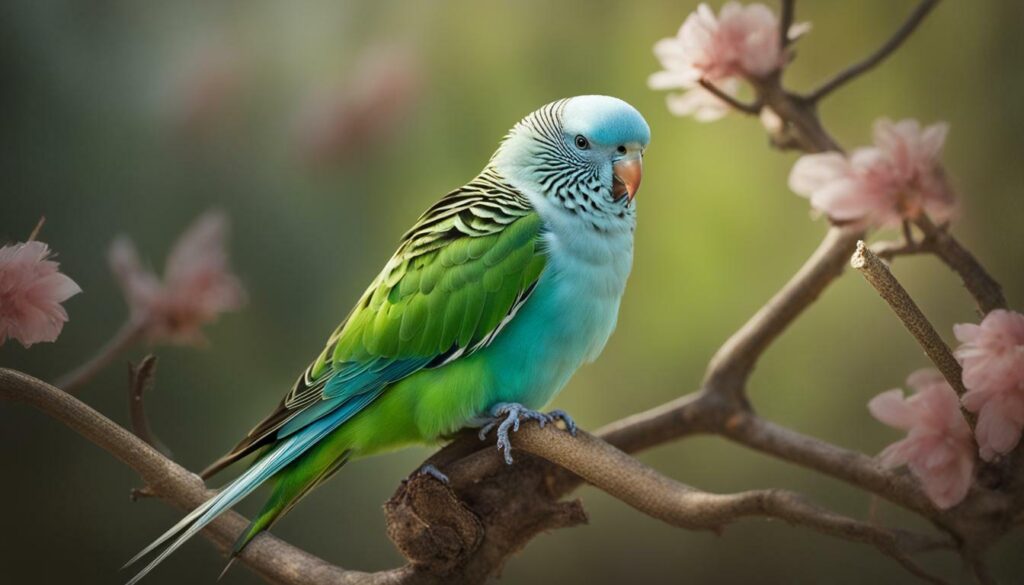
| Key Takeaways: |
|---|
| Parakeets sleep with one eye open, a behavior known as unihemispheric slow-wave sleep. |
| This adaptation helps them stay vigilant while still getting the rest they need. |
| Providing a safe and quiet sleeping environment is essential for their well-being. |
| Observing a parakeet sleeping with one eye open is a fascinating sight. |
“It’s mesmerizing to see a parakeet sleeping peacefully, yet at the same time, being aware of its surroundings. Their ability to sleep with one eye open is truly an incredible phenomenon.” – Parakeet enthusiast
Understanding Parakeet Sleep Patterns
While parakeets do sleep with one eye open, it’s important to note that they also experience periods of deep sleep with both eyes closed. During these restful moments, they may tuck their heads under a wing or fluff up their feathers for added warmth and comfort.
Parakeets typically require around 10-12 hours of sleep per day to ensure their overall health and well-being. It’s essential to establish a consistent sleep routine for your parakeet, providing them with a calm and undisturbed environment during their designated sleeping hours. By prioritizing their sleep needs, you can help them maintain a healthy sleep-wake cycle and ensure they remain happy and energetic throughout the day.
Understanding and respecting the unique sleep habits of your parakeet is an important aspect of caring for these delightful birds. By providing them with a safe and comfortable environment, you can enable them to sleep soundly and flourish as beloved companions in your home.
Are Parakeets Tropical Birds?
The vibrant colors and lively nature of parakeets might make you wonder if they are native to tropical regions. Let’s uncover the truth about their origins.
Contrary to popular belief, parakeets are not tropical birds. They actually originate from various regions around the world, including Australia, Asia, and Africa. While some parakeet species do inhabit tropical areas, many are found in a range of climates, from temperate to even arid environments.
One of the most common parakeet species, the budgerigar, or budgie, is native to the arid regions of Australia. These small and colorful birds have adapted to survive in the dry, desert-like conditions of their natural habitat.
So, while parakeets are known for their vibrant plumage and lively personalities, it’s important to remember that they can thrive in a variety of climates and environments.

| Parakeet Species | Native Region |
|---|---|
| Budgerigar (Budgie) | Australia |
| Indian Ringneck Parakeet | India and surrounding regions |
| Monk Parakeet (Quaker Parrot) | South America |
| Alexandrine Parakeet | India and Southeast Asia |
| Lineolated Parakeet | Mexico and Central America |
As you can see, parakeet species come from diverse regions across the globe, each with its own unique characteristics and adaptations. So, whether you’re considering getting a parakeet as a pet or simply have a fascination with these beautiful birds, it’s important to appreciate their global origins and understand their needs based on their specific species.
Parakeet Personality Traits
Parakeets have captivated bird lovers with their charming personalities. Let’s take a closer look at their endearing traits and behaviors.
One of the most delightful aspects of owning a parakeet is their social nature. These small birds thrive on companionship and enjoy interacting with their human caregivers. They are known for their ability to form strong bonds, often developing a deep attachment to their owners. Parakeets love to be near their humans, whether it’s perching on their shoulder or chirping away from their cage. Their social nature makes them a joy to have as pets.
Intelligence is another remarkable trait found in parakeets. These birds are quick learners and have an impressive ability to mimic sounds. With patience and consistency, you can teach your parakeet a variety of tricks and behaviors. From imitating human speech to performing simple acrobatics, parakeets are eager to show off their intelligence and entertain their audience.
| Parakeet Personality Traits | Summary |
|---|---|
| Social Nature | Parakeets are social birds that form strong bonds with their human caregivers. |
| Intelligence | They are quick learners and have the ability to mimic sounds and perform tricks. |
| Playfulness | Parakeets are known for their playful nature, enjoying toys and engaging in interactive activities. |
| Curiosity | They have a natural curiosity and enjoy exploring their environment. |
| Adaptability | Parakeets are adaptable birds that can easily adjust to new environments and routines. |
Playfulness is another endearing trait of parakeets. These birds love to play and explore. Providing them with a variety of toys, such as bells, swings, and puzzle toys, can keep them entertained for hours. Parakeets enjoy interactive activities, such as flying through hoops or solving treat puzzles. They are always up for a game and will eagerly engage with their toys and their human companions.
Curiosity is a natural characteristic of parakeets. These birds are inquisitive by nature and enjoy exploring their surroundings. Whether it’s investigating new toys or investigating every nook and cranny of their cage, parakeets are never short on curiosity. Providing them with a stimulating environment that offers new experiences and challenges can help satisfy their inquisitive nature and keep them mentally stimulated.
Parakeets are also incredibly adaptable birds. They can easily adjust to new environments and routines, making them suitable companions for individuals or families with varying lifestyles. Whether you live in a small apartment or a spacious house, parakeets can thrive in different settings as long as their basic needs are met. Their adaptability contributes to their popularity as pets and their ability to bring joy to a wide range of households.
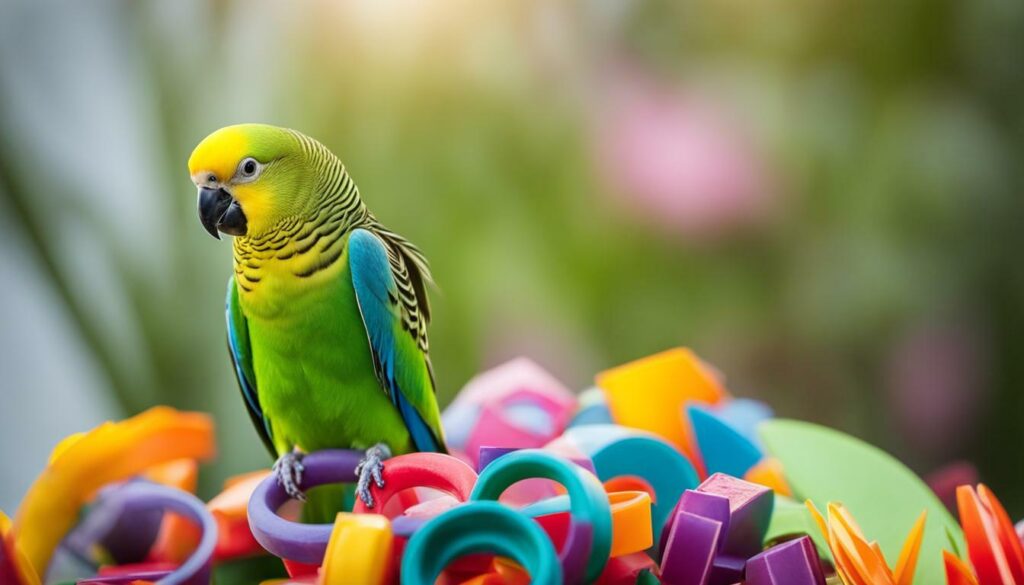
Congratulations! You now possess a wealth of knowledge about the care and keeping of parakeets. Remember to apply these insights and enjoy your incredible journey with these delightful avian companions.
Throughout this article, we have discussed the various aspects of parakeet care, starting with the basics of creating a safe environment. We learned about the importance of choosing the right-sized cage, placing it away from drafts and fumes, and providing natural branch perches for optimal comfort.
We then explored the significance of a balanced diet, emphasizing the inclusion of high-quality pellets, fresh fruits, and vegetables while avoiding potentially toxic foods. Regular grooming, including bathing and feather maintenance, is essential for their well-being, as is the routine cleaning of their cage to maintain a clean and hygienic environment.
Keeping parakeets mentally stimulated and physically active is crucial, and we discussed the importance of toys, perches, and training exercises to promote their overall well-being. Additionally, we delved into the significance of regular vet check-ups, managing stress, and being aware of potential health concerns.
| Section | Keywords |
|---|---|
| Section 1 | parakeets, caring for parakeets |
| Section 2 | parakeet care |
| Section 3 | safe environment for parakeets |
| Section 4 | parakeet cage |
| Section 5 | parakeet diet, balanced diet for parakeets |
| Section 6 | parakeet grooming, cage cleaning |
| Section 7 | parakeet toys, mental stimulation for parakeets |
| Section 8 | parakeet health concerns, managing parakeet health |
| Section 9 | bonding with parakeets, training parakeets |
| Section 10 | parakeets, sleep with eyes open |
| Section 11 | parakeets, tropical birds |
| Section 12 | parakeet personality traits |
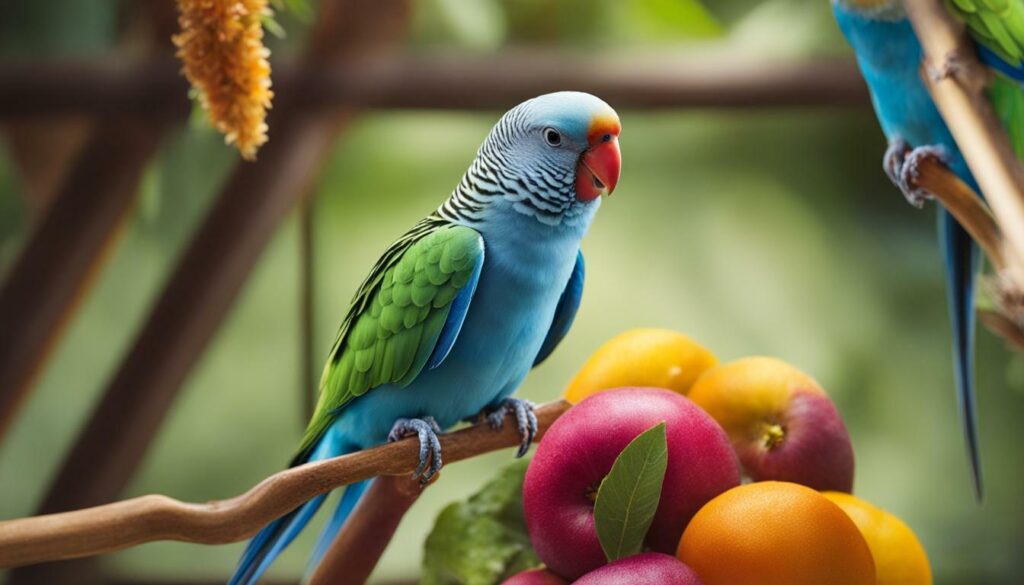
Remember that building a bond with your parakeet takes patience and a gradual approach, allowing the bird to gain trust. By providing them with a loving and caring environment, you’re giving them the best chance at leading a happy and healthy life.
So, go ahead and put your newfound knowledge into practice. Create a safe and stimulating environment, offer a well-rounded diet, and develop a strong bond with your feathered friend. With these guidelines, you’re set for a rewarding journey as a parakeet owner.
References
Here are the sources used to compile the valuable information provided in this article on caring for parakeets.

Key Takeaways:
- Caring for parakeets involves creating a safe and comfortable environment.
- Choosing the right-sized cage and suitable placement is crucial for their well-being.
- Providing natural branch perches, toys, and activities keeps them mentally stimulated.
- Feeding a balanced diet of quality pellets, fresh fruits, and vegetables is essential.
- Regular grooming, including bathing and cage cleaning, is necessary for their hygiene.
These key takeaways will help you ensure the happiness and well-being of your parakeet. Remember, it’s important to provide a safe and comfortable living space, a nutritious diet, and mental stimulation to keep them healthy and happy.
About the Author
Meet the author behind this informative article on caring for parakeets and discover their passion for providing valuable insights to bird enthusiasts. As a copywriting journalist, I have dedicated my career to creating engaging and informative content for various topics, including pet care. With a love for animals and a particular interest in birds, I have spent years researching and gaining knowledge about the specific needs and care requirements of different avian species.
Through my writing, I aim to share practical advice and helpful tips that can assist bird owners in providing the best care for their feathered friends. Caring for parakeets is a rewarding experience, but it requires a deep understanding of their unique needs and behaviors. By combining my writing expertise with my passion for avian care, I hope to contribute to the well-being and happiness of parakeets everywhere.
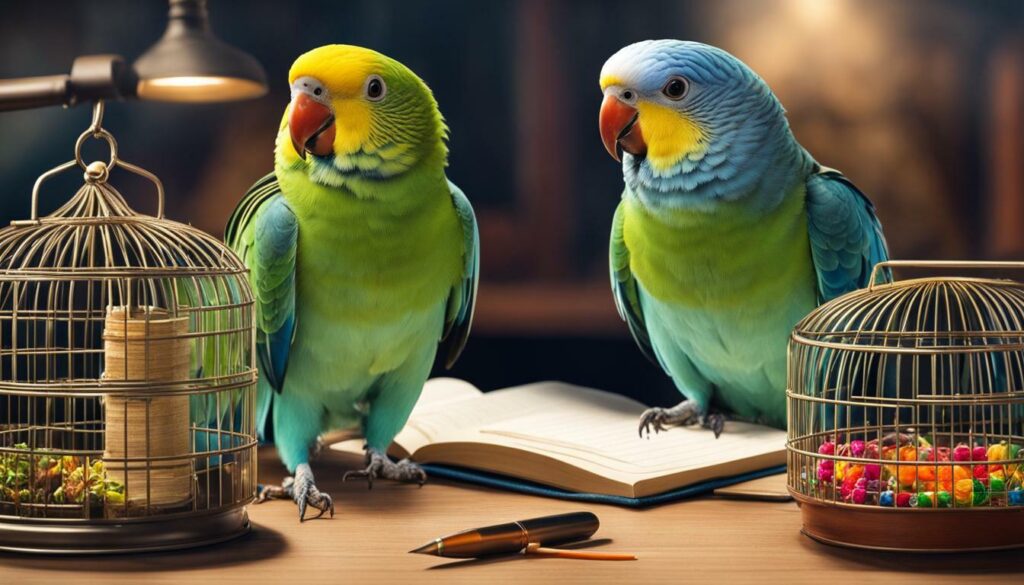
- Caring for parakeets involves creating a safe environment with the right-sized cage and suitable placement away from drafts and fumes.
- Provide various natural branch perches, toys, and activities to keep parakeets mentally stimulated.
- Feed them a balanced diet consisting of quality pellets, fresh fruits, and vegetables, while avoiding toxic foods.
- Regular grooming, including bathing, feather maintenance, and cage cleaning, is essential for their well-being.
- Keep parakeets mentally stimulated and active through toys, perches, and training exercises.
Disclaimer
The content provided in this article serves as a guide for parakeet care but should not replace the advice of a qualified avian veterinarian.
Caring for parakeets involves creating a safe environment that caters to their unique needs. This includes providing the right-sized cage, suitable placement away from drafts and fumes, and ensuring proper ventilation. A spacious cage with natural branch perches allows parakeets to exercise and feel comfortable in their living space.
Mental stimulation is crucial for parakeets’ overall well-being. Toys, perches, and training exercises can keep them mentally engaged and physically active. It is essential to offer a balanced diet consisting of high-quality pellets, fresh fruits, and vegetables while avoiding toxic foods that may harm their health.
Grooming and maintenance are vital aspects of parakeet care. Regular bathing, feather maintenance, and cleaning of their cage help maintain a clean and hygienic environment. Additionally, regular veterinary check-ups, stress management, and awareness of potential health concerns contribute to their optimal health.
Bonding and training parakeets require patience and a gradual approach. Building trust and a strong bond with your feathered friend will ensure a harmonious relationship. Remember that each parakeet has its own unique personality traits, including their social nature, intelligence, and ability to mimic sounds.
While this article provides valuable insights into parakeet care, it is important to consult a qualified avian veterinarian for personalized advice. They can provide expert guidance tailored to your specific parakeet’s needs, ensuring their well-being and longevity.
FAQ
What size cage do parakeets need?
Parakeets should have a cage that is at least 18x18x18 inches to provide enough room for them to move around comfortably.
Where should I place my parakeet’s cage?
It’s best to place the cage in a quiet area away from drafts, direct sunlight, and fumes from cooking or cleaning products.
What should I feed my parakeet?
Parakeets should be fed a balanced diet consisting of high-quality pellets, fresh fruits, and vegetables. Avoid feeding them chocolate, avocado, caffeine, and sugary foods.
How often should I clean my parakeet’s cage?
Regular cage cleaning is important for maintaining a clean and hygienic environment. Aim to clean the cage at least once a week, removing any droppings, uneaten food, and replacing the bedding.
How can I keep my parakeet mentally stimulated?
Providing toys, perches, and training exercises can keep your parakeet mentally stimulated and active. Rotate toys regularly to keep them engaged and offer a variety of activities like puzzle toys and foraging opportunities.
What are common health concerns in parakeets?
Common health concerns in parakeets include respiratory infections, mites, and nutritional deficiencies. Regular vet check-ups, a balanced diet, and a clean environment can help prevent these issues.
How can I bond with my parakeet?
Bonding with your parakeet takes time and patience. Start by spending time near the cage, talking softly to them, offering treats, and gradually working towards gaining their trust.

